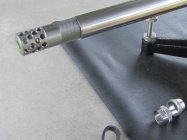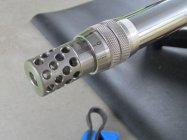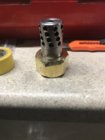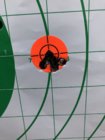I've not shot a match without a tuner since 2007 or 2008. They are, IME, great at what they do. They will not fix gun problems or shooter error. Nor will they make a perfectly tuned rifle, more perfectly tuned, as that's not possible.
What they will do, is give a wider tune window and keep a rifle perfectly tuned through a wide range of temperatures and allow your "hot" weather load to shoot in cold weather. IME, in every single instance, a known good load in a particular rifle has a tuner setting that it will shoot at it's best at. So, instead of changing powder charge or seating depth to keep up with tune, you simply nudge the tuner and accomplish the same thing. The better the barrel is dampened, to more forgiving to load variables it will be, as well.
The most common mistake in using a tuner is making too big of adjustments. Very small adjustments are all it takes. Often there are multiple good tunes in a single revolution of the tuner. So, being methodical in finding your tuner adjustment window is critical. I can assure you frustration if you just start cranking randomly.
The window will vary with tuner design, barrel length, contour, etc, but once a good tune is found, keeping it tuned has, IME, always been done in a range of less than 1/4 turn...at the most.
With my tuner, it is more in the neighborhood of 1/8th of a turn. Tuners really are very simple to use....just be methodical in finding your tune window and stay in that range, throughout all reasonable temp changes and load changes.
An example:
Let's say you get one of my tuners installed on your proven gun, using proven loads...
Start shooting 2-3 shot groups at EACH MARK on the tuner, for at least a full revolution. Then examine the target to determine your best setting. On both sides of your best setting, you'll see the groups open up. Determine the width of this range of adjustment to establish what completely in and out of tune "look like". Then go back to it and fine tune from there, moving fractions of a single graduation, staying within that range of adjustment.
When first working up loads, finding your range is less simple, but still very easy. I work up loads with the tuner installed, but it can be done with it off, also. I just leave the tuner set at zero...or wherever..and go about my load development as I would without a tuner. Once I've settled on a load, keeping that load shooting is as simple as barely turning the tuner...most often less than 1 mark on the tuner! Each mark on my tuner is equivalent to .002" fore and aft movement.....Amazing isn't it?
FWIW, I seldom have to move the tuner at all. The tune window(conditions) is usually wide enough that where ever it was last shot is likely in tune or very close. Most commonly, if I move it, it's on the first target or warmup, and it never needs touching again on that day. With a small window for range of adjustment, you'll never be far off from your ideal tuner setting. This is important to note in matches where sighters or warmups aren't allowed, but it's never a bad idea to check your tune on paper when allowed.
I hope this helps!---Mike Ezell
















